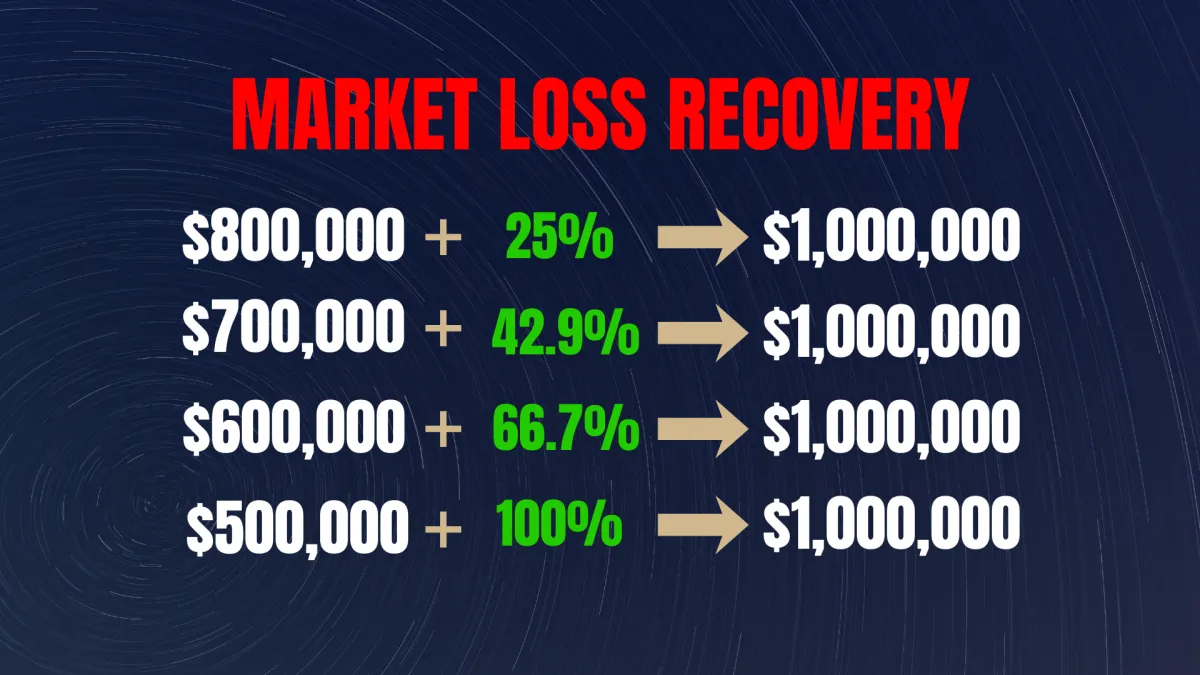
How Market Losses Impact Your Retirement
Most investors understand that market losses are frustrating, but very few understand how deeply those losses impact long-term retirement security. A decline in your portfolio is not simply a temporary setback. It often requires far more recovery than the initial drop, and the timing of those losses can shape the entire course of your retirement.
When you understand the math behind losses and the risks that come with withdrawing money during down years, you can design a retirement plan that is far more stable and predictable.
The Math Behind Market Declines
Recovering from a loss always requires a larger gain because your portfolio is growing from a smaller base. If your portfolio starts at $1,000,000 and drops to $900,000 after a 10% loss, you no longer earn returns on $1,000,000. You now earn returns on $900,000, which slows your recovery.
Here is how losses impact a $1,000,000 portfolio and the growth required to get back to even:
A 10% loss drops the portfolio to $900,000. Recovery requires 11.1% growth.
A 20% loss drops the portfolio to $800,000. Recovery requires 25% growth.
A 30% loss drops the portfolio to $700,000. Recovery requires 42.9% growth.
A 40% loss drops the portfolio to $600,000. Recovery requires 66.7% growth.
A 50% loss drops the portfolio to $500,000. Recovery requires 100% growth.
The deeper the loss, the harder the climb. A 50% loss requires your portfolio to double just to return to $1,000,000.
Why Losses Are More Dangerous in Retirement
Losses hurt at any stage, but they are especially damaging once you begin withdrawing income. This is called sequence of returns risk.
Imagine you planned to use the traditional 4% rule, withdrawing $40,000 per year from a $1,000,000 portfolio. If the market drops 20% and your portfolio falls to $800,000, taking the same $40,000 now requires a 5% withdrawal rate.
Your portfolio is hit twice.
You lose money from the market decline, and you remove money at the same time.
This accelerates depletion and can shorten your retirement by years. If back-to-back losses happen early in retirement, the portfolio may never recover. Timing, not average returns, becomes the biggest threat.
Why You Need Sources of Income Not Tied to the Market
Since no one can predict when a downturn will occur, the strongest retirement plans include income sources that remain stable even when markets fall. These sources act as a backstop. When the market drops, you can shift income away from your investment accounts and allow them time to recover.
Two tools are especially effective: whole life insurance and annuities.
Whole Life Insurance as a Volatility Buffer
Whole life insurance builds cash value that grows every year through guaranteed interest, often around 3%, with the potential for dividends from a mutual carrier.
This creates a pool of money completely insulated from market volatility.
Here is how it protects your retirement:
Market drops.
You pause withdrawals from your 401(k) or IRA.
You pull the needed income from your whole life cash value instead.
You allow your investments time to rebound without locking in losses.
A single down year early in retirement can permanently damage your portfolio. A whole life volatility buffer helps prevent that damage and protects your long-term income plan.
Annuities as Guaranteed Lifetime Income
Annuities provide another layer of stability. When you place a lump sum into an annuity, the carrier guarantees an income stream for life.
For example, placing $1,000,000 into an annuity with a 6% payout factor provides $60,000 per year for as long as you live.
This income is not affected by market performance. It arrives every year, consistently and predictably.
When combined with Social Security and whole life insurance, annuities help create a retirement structure that can survive both good and bad market cycles.
A Retirement Plan Built for Real Life
The strongest retirement strategies combine three elements:
Market-based accounts for long-term growth
Whole life insurance to protect withdrawals during down years
Annuities for guaranteed lifetime income
This three-part structure eliminates the need to rely on market timing, reduces fear during downturns, and builds confidence that your income will last.
A retirement plan built on both growth and guarantees is far more resilient than one relying entirely on market performance.
Build a Future That Can Withstand Market Cycles
Market losses will always happen. What matters is how you prepare for them. When your retirement plan contains tools that protect your income during down years, you gain stability, peace of mind, and the freedom to make decisions from a place of strength rather than fear.
If you want to see how these strategies could strengthen your retirement plan and create true long-term security, book in a call here.
